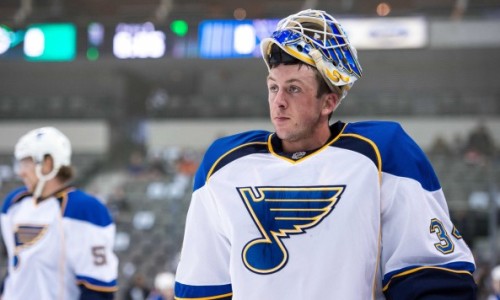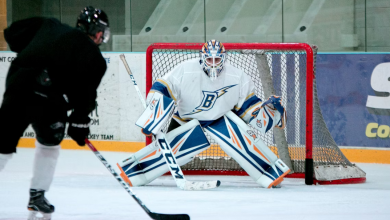Is Jake Allen the odd man out for the St. Louis Blues?

The decision by the Blues to sign goaltender Brian Elliott to a three-year contract was a stunner that will have lasting effects on the goaltending situation in St. Louis.
Jake Allen – the Blues’ great goaltending prospect – will now have to fight with Brian Elliott to get the starter’s role next season. But after the Blues committed $7.5 million to Brian Elliott over three years, the bigger question is whether or not Allen is the odd man out.
Even without Elliott’s contract the writing was (or should have been) on the wall after the Blues traded for Ryan Miller. The team made a huge investment by trading away its number one goalie Jaroslav Halak, young power forward in Chris Stewart, plus two draft picks and a prospect.
So when the team opted not to bring him back – after everything they gave up getting him – as a result of the signing, the team’s intentions were clear. Unless Jake Allen is so exceptional in training camp and the pre-season that the team can’t say no, he won’t get the starting job.
If that is, in fact, the case then the team will need to figure out what it wants to do in the crease. Elliott hasn’t exactly been embraced as a starter – his workload with the team reflects as much – and with Miller not coming back and Allen seemingly on the outside looking in there’s nowhere else to go.
Another puzzling part of Allen’s situation is how his role with the team has been handled. First, he hasn’t been signed yet, which is odd considering he is a restricted free agent after the 2014-15 season and is one of the team’s top three goaltending prospects. Most teams would have signed him at this point.
Second, Allen has only played 15 games in the NHL – all in the 2012-13 season – and went 9-4 in that time. In that time he also came up with one of the saves of the year, which doesn’t really mean much, but was fun to watch.
But if the Allen-less path is the one the Blues wish to take then they’ll need to look for a successor to Brian Elliott for when his contract ends. Unfortunately for the team the free agent market is thin in terms of young could-be starters.
Alex Stalock of the San Jose Sharks is basically the only attractive option. He went 12-5-2 as the backup for Antti Niemi with a sub-2.00 GAA. He is still only 26 years old so he would have a few years to prime himself for the starting position should the team choose to go that route.
The other option is to try to draft the goalie of the future at this year’s draft in Philadelphia. Much like the free agent market, the pool of prospects at the draft is also very thin with many of the goalies either not good enough or not experienced enough to warrant any consideration.
Thatcher Demko – an 18-year-old playing with Boston College – is an exception to that. Prior to BC he spent two years in the United States Hockey League where he played 34 games and finished with a 24-6-0 record. This year he put up 16 wins in 24 games with two shutouts, along with a 2.24 GAA and .919 save percentage.
Of course it’s hard to say at the moment if he’ll become a regular starter in the NHL. But if he can continue to improve his game, and fill out his 6’3” frame, anything is possible.

